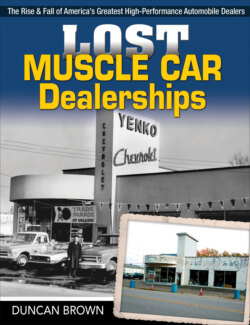Читать книгу Lost Muscle Car Dealerships - Duncan Scott Brown - Страница 33
На сайте Литреса книга снята с продажи.
The Bardahl Car
ОглавлениеThe general consensus is that one of the earliest Dana Camaro package conversions was a white 1967 Camaro SS 350 converted to 427 power. This early car was built as a specific Dana Camaro according to the packaging formula laid out for a Dana Camaro.
This car has been nicknamed the Bardahl Car because it was destined to go to the Bardahl Oil Company to test lubricants at speed. Bardahl loaded the Camaro from the factory with vinyl roof, tinted glass, Rally Sport package, custom interior, etc. The “Bardahl Camaro” Dana package was the base 427 Dana conversion.
The Bardahl Camaro was used for photo shoots and testing in Camaro magazine, Car Life magazine, and Motor Trend magazine. Photo and story lead-ins could be as early as December 1966, and no later than winter 1967. The Dana Bardahl car was first seen in Camaro, which was likely released in late 1966 or early 1967.
The April 1967 issue of Car Life tested the Dana 427 “Bardahl Camaro.” The writers were not impressed with the rear braking lockup caused by extra upfront weight of the 427. The proportioning valve was set up for the 350. When Car & Driver tested a Nickey/Bill Thomas 427 Camaro, it also encountered early rear wheel lockup because of excess weight up front.
Car Life also criticized the Dana Camaro’s suspension, which was Chevy heavy-duty SS stuff, plus Traction Masters, which prevented spring wind up. The Car Life assessment dovetailed with the later Motor Trend test regarding lack of traction hindering acceleration runs on street tires. Car Life saw a top speed of 130 mph and got 14.2 at 102 mph on the quarter with a non-Posi 3.55:1 axle. Chassis tweaking could take 2 full seconds off without doing anything else to the car.
The thing people forget when wondering why Chevy bent the rules to let the Corvette get the monster 427 was that the chassis was better suited to handling the power. Corvette’s chief engineer Zora Arkus-Duntov was opposed to big engines in his Corvette. But when a big-block was plunked into a Corvette, nearly 50-50 weight balance was still possible because the engine was mounted rearward. This is particularly noticeable in 1968 and later “Shark” Corvettes. You are sitting beside the transmission in those cars. Vettes also had four-wheel disc brakes. When COPO ZL1 Camaros were built, the light aluminum 427 solved a lot of the handling issues.
Pictures of the Car Life test car indicate that the Bardahl Camaro didn’t have the optional lightweight fiberglass Dana hood with functional air intakes, which was produced and sold to Dana, as the hood development was not completed until May 1967 and later offered to the public in October 1967 by Berry Plasti-Glass. The Dana hood was on the Bardahl Camaro when Motor Trend got it. Shaving some weight off the front end may have contributed to positive reviews from Motor Trend. This also smacks of the Peyton Cramer touch, having learned this trick from Carroll Shelby on his GT350 and GT500s with their unique lightweight front ends.
Motor Trend’s July 1967 test of the Bardahl Camaro noted that Peyton Cramer was duplicating his former employer (Carroll Shelby) by offering a super pony car for the same $3,995 base price as a Shelby Mustang GT350. Shelby’s big-block monster 428 version of the Mustang, named GT500, was more expensive.
Part of the trick with Dana’s pricing was that the customer received a credit for the yanked 350 engine, which was a saleable performance piece that had just debuted as an exclusive powerplant for the 1967 SS Camaro.
The Motor Trend test Camaro overwhelmed the street tires in quarter-mile tests. First gear couldn’t be used on the F70-14 tires because the 3.73:1 rear axle put the rear end around and torched the tires. Incredibly, quarter-mile times of 14.2 at 105 mph were clocked using either second or third gear to start. Top speed on this Dana test car was 130 mph. Note that top speed and quarter-mile ET were the same as the car when tested by Car Life with a 3.55 rear end.
When Goodyear slicks were filling the rear wheel well, the Camaro ripped off a quarter-mile in 13.3 at 107 mph.
Uncorking the headers dropped times into the high 12s. This was all with the basic car! If you wanted to go faster, there were packaged options available.
Customers spending more money could have Dana tweak the platform with an optional engine upgrade to the 3x2-barrel 435-hp V-8 ($150) in addition to Stage I ($235) and Stage II ($275) suspension upgrades for street use, and a Stage III ($2,000) package intended for all-out drag racing. These packages may have been devised to address the criticisms leveled in the Car Life test. Dick Guldstrand put years of racing experience into these performance packages.
